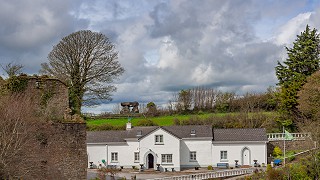Cadamstown
- Co. Offaly
- Listed in Villages



Cadamstown or Baile Mac Adaim, situated at the Foothills of the Slieve Blooms, on the banks of the Silver River was at one time home to Charles O’Carroll whose Grandson was a signatory of the Declaration of American Independence in 1776.
The village has many scenic walks including the start of the Offaly Way - an official Way- marked walking route. The village also has a picnic area, public house, shop/post office and teashop.
History of Cadamstown
This ancient parish is situated in the foothills of the Slieve Bloom Mountains, it was known from very early times as Leitir Lughna. The place name, translated from the Irish means “Wet Hillside of Lughna”. The Lughna in question being the founder saint who established a church there in the 6th century or perhaps much earlier.
Baile Mac Adaim, Cadamstown, was the old name for the town and castle. Local historian, Tobias Chambers, in his history of the area, mentions that McAdaim was a northern chieftain who settled in the area. Another explanation is that as the plantation Eile, by the 1640s was in the possession of Adam Lord Viscount Loftus of Ely, that the “Adam” in question is in fact the Lord Viscount himself.
The Mill
The first mill of which there is a record was a small thatched structure, part of which is still standing. William McMorrow built this mill. McMorrow was one of the northern families who came with Hugh O Neill in 1601. The old mill dated from 1604; it was a flourmill and a spade mill. The McMorrows operated the mill until 1656-7. When the area was granted to the Manifold family, the McMorrows vacated the mill.
Manifolds operated the mill for some time until the locals burnt it to the ground; Charred and burnt marks can still be seen over the doorway, There was no mill in Cadamstown until 1831 when Sina Manifold, Dan Manifold’s wife, built the present mill. The old abbey of Leitir Lughna was pulled down and the stones used in the construction of the mill.
Manifolds sold the mill in 1890. William Slevin, from Belfast, converted it into a woollen mill. The old mill is now silent but many tourists come to admire its great stonework and research its history.
Millers House
Opposite the mill stood the miller’s house. During the 1798 rebellion it was used as a yeoman’s barracks. When the rebellion was over it was used again as the miller’s house. Dan Manifold resided there. When William Slevin bought the property he lived there with his son Pat. James Gaffney became owner when the Slevins died and Paddy Heaney currently owns the house and everyone is welcome to visit and hear the stories of the old mill.
St. Luna’s Abbey
Luna or Lughna, according to several ancient authorities was the luminary of St. Patrick and the son of his sister Liemanis. Local tradition states St. Patrick did pass through the area on his way to Clareen.
The site of the ancient monastery of Leitir Lugna, dating perhaps from the sixth century, lies one mile south of the village of Cadamstown. Leitir Lughna monastery, according to the old historians, was formerly surrounded by an ancient earthen embankment faced with stone. According to the book of Clonreagh, in the townsland of Leitir are the ruins of a church. There is a holy well near the church called Tobar Lughna, the water from which was once believed powerful in curing diseases of the eye.
In 1688 Tobias Chambers wrote a history of Leitir Lughna. He recorded that when Hugh O Neill passed through on his way to Kinsale in 1601 he donated money to rebuild the church; although there is no evidence that this was done.
Leitir was destroyed in 1650 by General John Reynolds and his army of 16,000 men. It was apparently the masonry from this building, which provided some of the material for the construction of the mill in 1831, and the Catholic Church in 1842. John Manifold took up residence at the nearby Leitir House and proceeded to demolish the ruined old church and reclaim the adjoining lands. The story goes that the Manifolds also excavated the old graveyard (the marks of which still remain at the site) and placed it as top-dressing on the field called the “Sally Meadow”. Shortly afterwards, the field turned white from the bones, which were among the graveyard clay and the local workmen refused to continue with their work. The patron day was held at Leitir on 25th of April every year until discouraged by the Manifolds in 1850, by filling in the well with stones.
Ardara Bridge
When was this bridge built? We do not know. Tobias Chambers mentions the bridge in his history of the area in 1688, when he recorded Hugh O Neill was marching south in 1601.
The bridge itself has been a source of interest for many years. It is built with dry stone, no mortar or lime used in its construction, except at water level. The wall was treated with lime and sand for three feet above the water line. It was built between the high rock face and rises to a height of thirty feet and beautifully arched with large sand stone flags interlocked into each other.
The bridge is named after the adjoining townsland of Ardara. The meaning of this name is unclear. Ardara could mean the high oaks or, as the gaelic scholar stated, it could mean “the height of the graves”. There were several Bronze age burial mounds in the vicinity many years ago but all have disappeared because of land reclamation.
